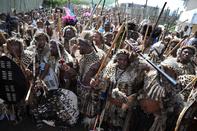Strength of the Zulu Nation
During the reign of Shaka and his successors, the growth and strength of the Zulu nation lay in its military organization and skills. The military was organized around the system of ukubuthwa 'to be enrolled' which largely did away with initiation ceremonies.

In terms of the system, each age-set, that is a group of young men of the same age, was incorporated into the same regiment - ibutho singular, amabutho plural. Ukubuthwa also applied to girls, but in most cases they belonged to an age-set rather than a regiment. The amabutho were accommodated at military barracks - ikhanda singular, amakhanda plural - throughout the kingdom, which were under the control of a close relative of the king or someone appointed by him.
The barracks were similar in design and layout to the ordinary umuzi, but on a much larger scale. In addition to military duties, the izinsizwa 'young men' were involved in the repair and maintenance of their barracks and were called upon to perform duties at both their barracks and the royal residence.
They functioned as keepers of the national herd, messengers for the king and domestic policemen, and also saw to crop production for the royal household. An important feature of military organization was that there were always men undergoing a period of military training and so it was easy for the king to assemble an effective military force at short notice.
Fighting Techniques
Fighting techniques devised by Shaka were revolutionary and played a significant role in the rise of Zulu military and political power. The first thing Shaka did was to change traditional fighting tactics. Prior to his reign, opposing armies had lined up and lobbed their spears at each other. Shaka introduced close hand-to-hand combat using long bladed, short-shafted stabbing spears.
He reduced shields to more manageable proportions and trained his men to use their shields to hook their opponent's shield and wrench it aside, thus exposing his left flank to the Zulu warrior's spear. Shaka also developed a strategy of concentrating his soldiers into a fighting formation resembling a buffalo head. In the centre or 'chest' was the greatest concentration of men, comprising the most experienced fighters.
They were deployed in two parallel formations, so that the soldiers in the front would engage the enemy, while those in the rear would be hidden from sight. This strategy was designed firstly to deceive the enemy into believing that they were being opposed by a relatively small force, and secondly so that the soldiers held in reserve would be able to reinforce the frontline soldiers if necessary. As they would be fresh, they could also chase and outdistance the defeated enemy in retreat.
Emanating from the chest were two horns whose purpose was to encircle the enemy. When attacking, a common tactic was to feint with one horn, while the other, concealed in the bush and long grass could sweep around unseen to surround the enemy. These tactics proved to be a decisive factor in the Zulu kingdom's dramatic rise to power.
When a regiment had accomplished a certain period of service to the king, which could be up to 10 years, the king would decree that the members of a particular age-set could marry and sew on the headring. One of the results of controlling the age at which men could marry was a balance in Zulu society between population growth and available resources.